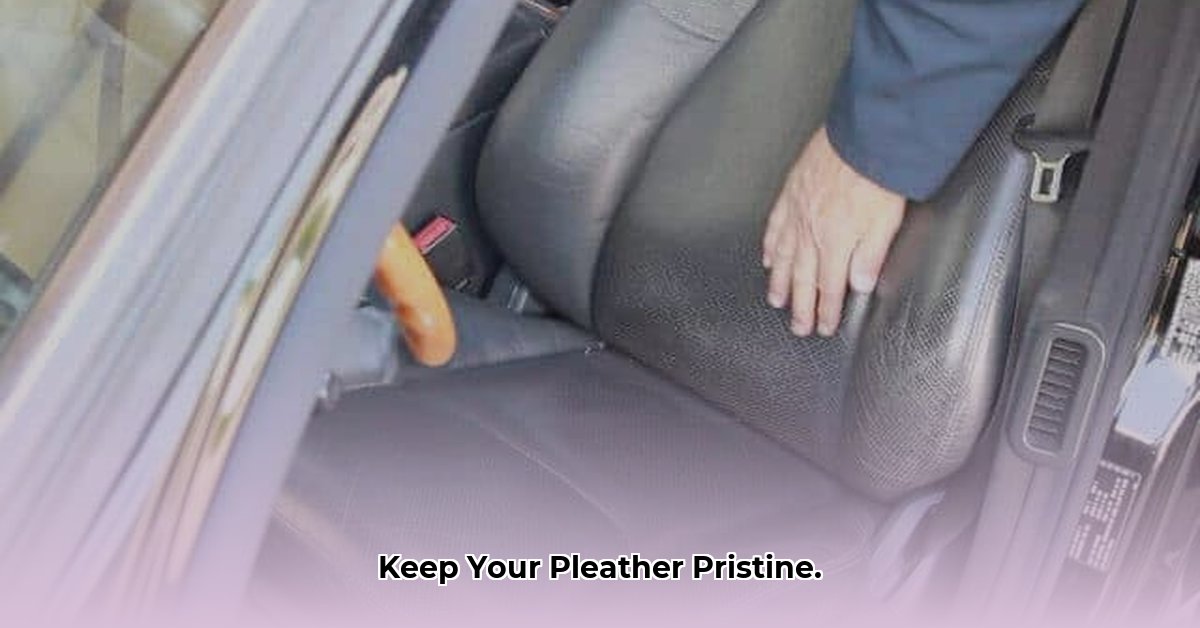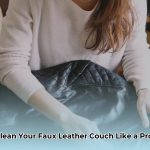Refreshing Your Faux Leather: Simple Steps for Sparkling Clean
Faux leather (or pleather) adds a touch of style without the leather price tag. But just like your favorite leather goods, it needs regular care to stay looking its best. This guide provides a simple, effective cleaning routine, along with expert tips for tackling stains and ensuring your pleather pieces last.
Everyday Pleather Care: Easy Maintenance for Lasting Beauty
Think of pleather care like a skincare routine – a little regular attention goes a long way. Dusting with a slightly damp microfiber cloth prevents dirt buildup and keeps things looking fresh. For a deeper clean, mix a few drops of mild dish soap with warm water. Dampen (don’t soak!) your microfiber cloth, gently wipe, and immediately dry with a separate clean cloth. Every so often, a tiny dab of baby oil or olive oil, gently rubbed in, can help maintain suppleness and prevent cracking.
Stain Removal SOS: Rescuing Your Pleather
Accidents happen. When a stain strikes your pleather, don’t panic! Most stains can be tackled with a slightly stronger dish soap and water solution. Apply directly to the stain and gently rub with a soft cloth. For stubborn marks like ink, isopropyl alcohol (rubbing alcohol) can be a lifesaver. Always test it on a hidden area first. Apply a small amount to a cotton swab and gently dab. Patience is key. Once the stain is gone, wipe with a damp cloth and dry thoroughly.
Your Pleather Stain Removal Cheat Sheet
| Stain Type | Solution | How to Apply |
|---|---|---|
| Food | Mild dish soap and water | Blot (don’t rub!). Rinse and dry. |
| Ink | Isopropyl alcohol (rubbing alcohol) | Dab gently with a cotton swab. |
| Grease/Oil | Baking soda paste (water + baking soda) | Apply the paste, let it sit, then wipe clean. |
| Makeup | Micellar water | Gently wipe with a cotton pad. |
Banishing Odors: Keeping Pleather Fresh
Pleather can sometimes absorb odors. Sprinkle baking soda generously over the affected area. Let it sit for 24 hours to absorb the smells, then vacuum or brush it away.
Pleather Don’ts: Avoiding Common Mistakes
Knowing how to clean pleather also means knowing what not to do.
- Harsh Chemicals: Avoid bleach or abrasive cleaners, which can damage the material.
- Excessive Soaking: Pleather isn’t waterproof. Wring out your cleaning cloths thoroughly.
- Heat and Sunlight: Never put pleather in the dryer. Heat can cause cracking. Direct sunlight can also be damaging, so keep pleather items out of direct sun. Air dry only.
Understanding Pleather: Why Special Cleaning Matters
Pleather, also known as faux leather, mimics the look and feel of real leather but is typically made from plastic coated with polyurethane (PU) or polyvinyl chloride (PVC). There’s also silicone-based pleather. Knowing the specific type can help refine your cleaning approach, but the basic principles remain the same. Pleather’s unique composition makes it sensitive to harsh chemicals and rough cleaning. Strong cleaners can strip its protective coating, leading to cracks and fading. Gentle cleaning is crucial.
Your Pleather Cleaning Toolkit
Gather your supplies before you begin:
- Soft Microfiber Cloths
- Mild Dish Soap
- White Vinegar
- Rubbing Alcohol
- Baking Soda
- Warm Water
- Vacuum with Soft Brush Attachment
- Spray bottle (optional, but helpful)
- Commercial Faux Leather Cleaner (optional)
- Conditioner designed for faux leather or vinyl (optional)
A Step-by-Step Guide to Cleaning Pleather
Preparation:
- Dust and Vacuum: Use a soft brush attachment on your vacuum to remove loose dust and debris.
Cleaning:
- Regular Cleaning: Mix a few drops of mild dish soap with warm water. Lightly dampen a microfiber cloth and gently wipe the entire surface. Rinse with a clean, damp cloth and buff dry.
- Stubborn Stains: Test any new solution on a hidden area first. For tougher stains, try equal parts water and white vinegar. Let it sit for a few minutes before wiping clean. If needed, carefully dab a small amount of rubbing alcohol onto a cotton swab and gently blot the stain. Alcohol can be harsh on certain pleather types, so proceed cautiously. There is ongoing research on safe cleaning solutions for specific types of faux leather.
- Disinfecting (For Biological Spills): For spills like blood, use a highly diluted bleach solution (1 part bleach to 10 parts water). Test on an inconspicuous area first, as bleach can sometimes discolor. Apply for no more than five minutes, then rinse thoroughly. Some experts recommend avoiding bleach entirely.
- Deodorizing: Sprinkle baking soda on the pleather and let it sit for a few hours to absorb odors. Vacuum or brush it off.
- Conditioning: Condition pleather about twice a year (more often in dry climates) with a product designed for faux leather or vinyl. Some people suggest coconut or olive oil as alternatives, but the long-term effects are still being studied.
Specific Item Care:
- Clothing: Check the care label. Some pleather garments are machine washable (inside out, gentle cycle). Hand washing is often safer. Air dry flat, away from heat.
- Accessories: Baby wipes can handle quick cleanups. For deeper cleaning, use the mild soap and water method. Pay attention to hardware and lining materials, which may require different cleaning approaches.
- Furniture: Test your cleaning solution in a hidden area first. Avoid over-saturating. Use a microfiber cloth. For stubborn stains, a specialized faux leather cleaner might be needed (test first!).
Long-Term Pleather Care
Avoid direct sunlight, which can cause fading and cracking. Blot spills immediately. Regular cleaning and conditioning are key to keeping pleather looking its best. While these guidelines apply broadly, the lifespan of pleather varies depending on material quality and care.
Troubleshooting Pleather Stains and Damage: A Practical Guide
Beyond routine cleaning, knowing how to address specific stains and damage can significantly extend the life of your pleather. Here’s a breakdown of common issues and effective solutions:
Stain Removal:
- Oil-based stains: Baking soda is your go-to. Sprinkle generously over the stain, let it sit for a few hours to absorb the oil, then brush or wipe away.
- Ink stains: Carefully dab (don’t rub) the stain with a cotton swab dipped in rubbing alcohol. Blot as you go to lift the ink.
- Water spots: A solution of equal parts white vinegar and water can work wonders. Apply, wipe, and dry.
Always test any cleaning solution on an inconspicuous area first, especially if dealing with a mystery stain.
Damage Repair:
- Minor scratches/scuffs: A liquid leather repair compound can fill in and mask imperfections.
- Larger tears/gashes: A pleather repair kit with adhesive patches might be necessary. Some flexible adhesives may also work, but more research is needed.
- Significant damage: Consult a professional upholsterer experienced with synthetic materials.
Preventative Care and Material Considerations:
Conditioning helps keep pleather supple. Experts have differing opinions on the best conditioners. Some recommend mineral or baby oil (avoiding silicone-based products), while others suggest specialized synthetic leather conditioners. More research may be needed to determine best practices. Apply a small amount and buff with a soft cloth. Avoid direct sunlight and excessive heat.
PU leather (polyurethane) and PVC leather (polyvinyl chloride) are two common types of faux leather. PU leather is generally more breathable and durable, while PVC is more affordable but may not last as long. However, both benefit from similar cleaning routines. There’s ongoing debate about the long-term durability and environmental impact of each. Future research may provide further insights.
- NYT Connections Answer: Hedgehog, Pineapple, Cactus The Spiky Things Explained - April 20, 2025
- How to Clean a Wool Carpet: A Comprehensive Guide - April 20, 2025
- How to Clean a Pleather Couch: A Complete Guide - April 20, 2025










